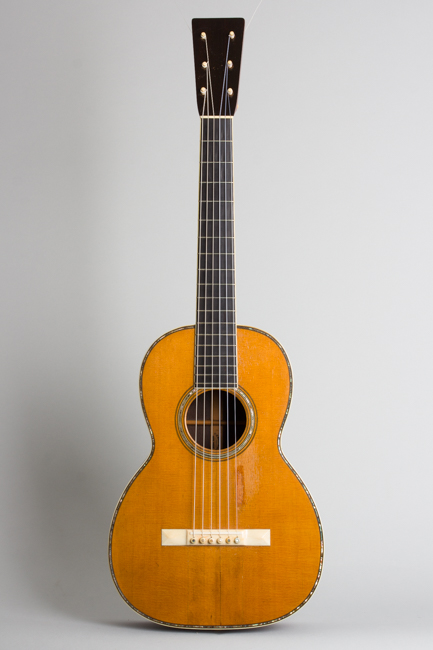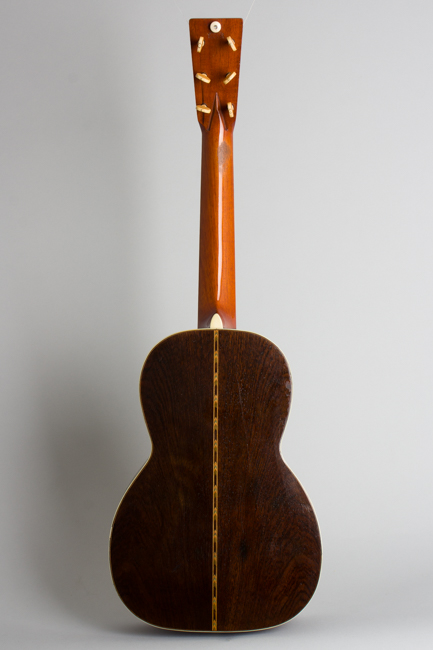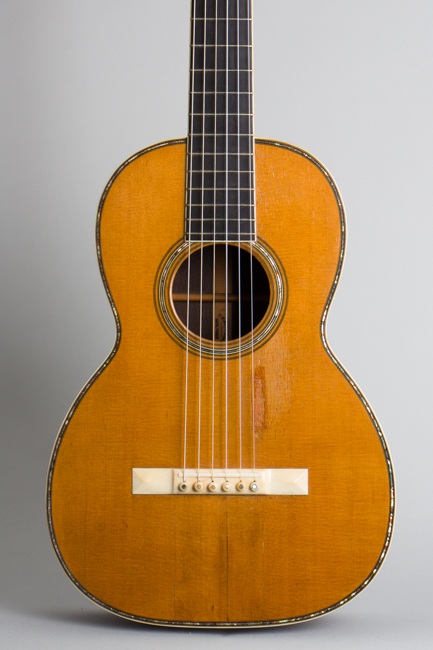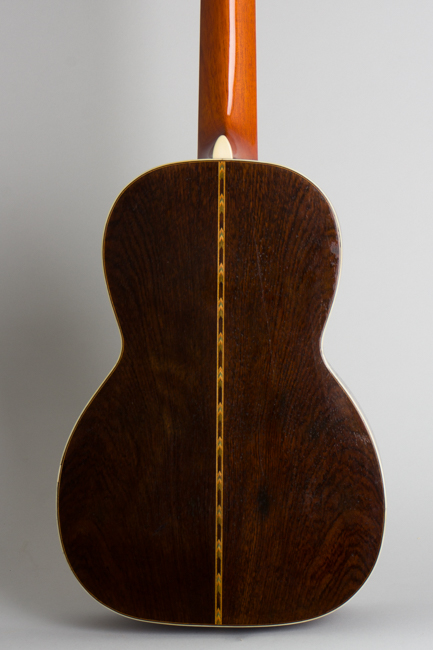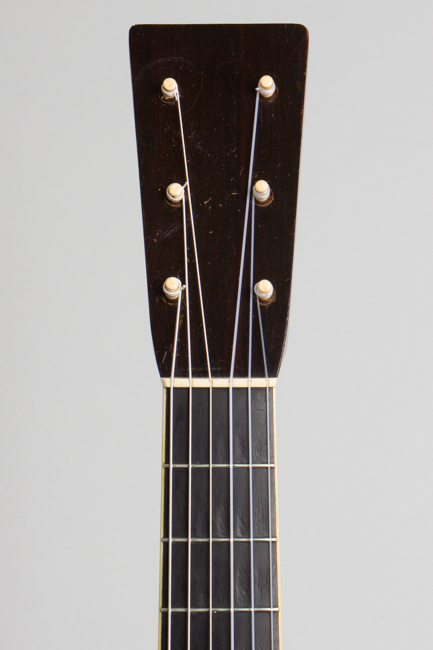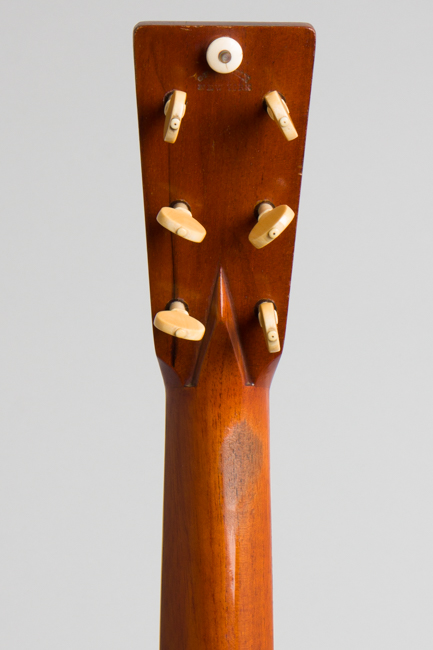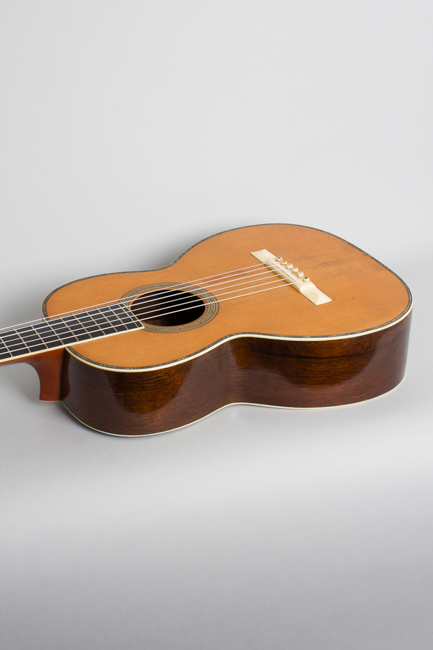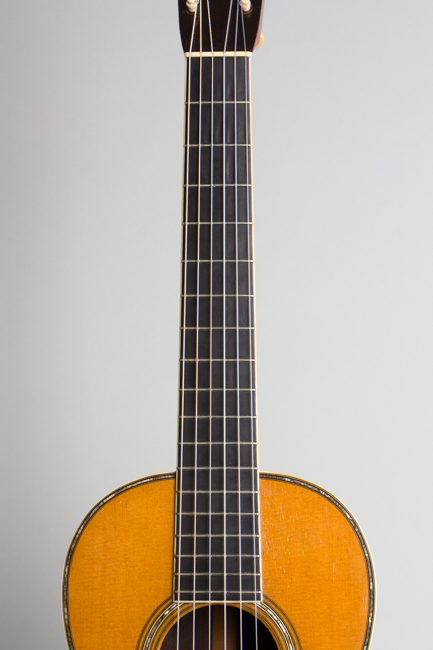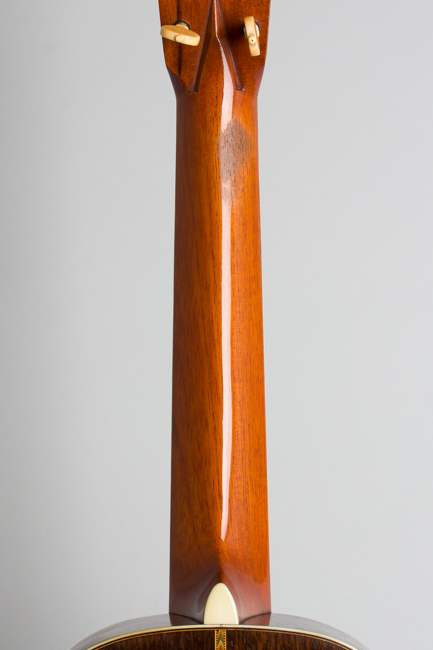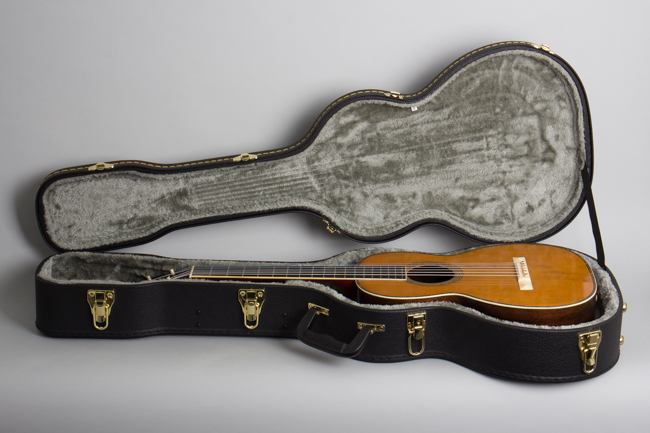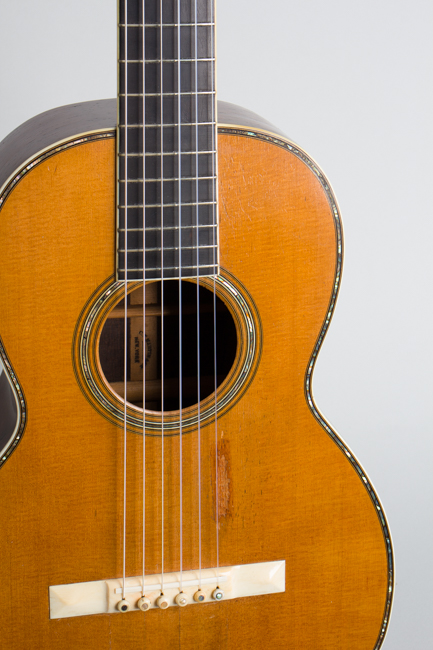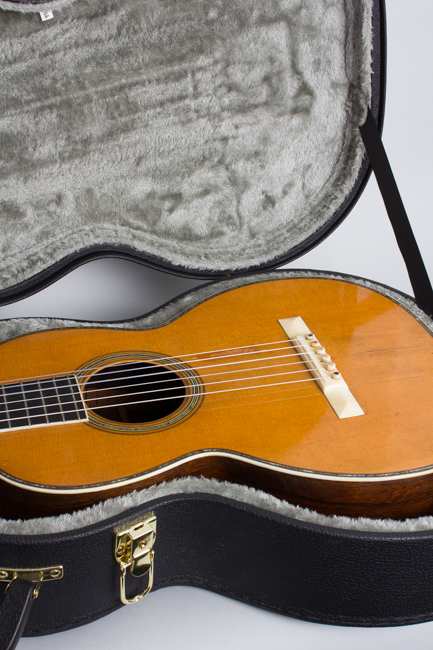C. F. Martin 4-40 Flat Top Acoustic Guitar , c. 1896
C. F. Martin 4-40 Model Flat Top Acoustic Guitar, c. 1896, made in Nazareth, PA, natural varnish finish, Brazilian rosewood back and sides, Appalachian spruce top; Spanish cedar neck with ebony fingerboard, black hard shell case.
This stunningly beautiful little Faberge egg of a pearl-top Martin is redolent of a time long past, on the surface at least a more civilized era! Now well into the 21st century the 1890's seem far away indeed. This is an extremely rare and delicate small-body flat top; it shows some wear and repair but remains a fine playing and particularly attractive instrument 125 or so years on.
This is a model 4-40, a style even dedicated Martin afficionados may have never seen. The "4" refers to the body size, only 11 1/2" wide at the lower bout, just a bit larger then the smallest Martin, the style 5. The scale length is correspondingly short at 22"; this guitar can be tuned and played as a 3/4 standard model or as a Terz guitar, tuned a third higher with the lowest string pitched to G instead of E.
Size "4" models do not appear to have made it into the 20th century, at least none are recorded as having been built in ANY style after published records begin in 1898. This guitar looks to date to just before than period; it cannot be assigned to a specific year as it bears no serial number nor handwritten markings under the top. Based on the construction and finishing details it would appear to have been made in the mid-1890s, not long before Martin switched the stamped markings from "C.F. Martin & Co, New York" to "C.F. Martin & Co, Nazareth PA".
When this guitar was made C. F. Martin was a very small shop; a good year was a few hundred instruments shipped. Their products were almost universally considered the finest of all American-made guitars made (although Lyon & Healy would have begged to differ!). At the time Martin (and indeed all "good" guitars) were designed exclusively for gut strings; steel strings on a guitar were then a new idea widely despised by the class of folks that could afford an instrument like this.
The Style 40 is also an obscure item in the 20th century; it was not listed in Martin catalogs by 1897 and only a handful were made in various sizes before the 1930's, when a Hawaiian-style 0040H was revived as a catalog item for a time. When this 4-40 was made it was the second highest grade offered, until the Style 45 appeared a few years later. Style 40 is distinguished from the Style 42 by the lack of a pearl border around the fingerboard, while they share pearl trim around the top edge and soundhole.
This guitar's back and sides are made from very dark Brazilian rosewood, with the tightest-grained Appalachian spruce for the top and extravagant blue, green, and pinkish hued abalone for the border inlay. There is an elaborate inlaid wood backstrip. The neck is Spanish Cedar with a grafted headstock and dark ebony fingerboard devoid of inlay. All binding is ivory, as is the bridge; the bridge pins and end pin are Ivory or bone with a pearl dot. The tuners are carved ivory "pegs" as Martin termed them; the solid headstock thus fitted was an option that could be ordered instead of a slotted head fitted with "machines" as geared tuners were called. An ivory pin for a cord strap is set into the back of the headstock.
The New York Martin logo is stamped on back of headstock, backstrip and neck block, where the mark is upside down! The top has extremely delicate scalloped X-bracing with a thin bridgeplate, suited for gut strings. At once opulent and austere, these pearl-trimmed Martins were the company's calling card in the Gilded Age. Martin's workers lavished their finest materials and workmanship on the Style 40 and 42 instruments, not relying on just decorative elements. Notwithstanding the finely wrought pearl bordering to the top, this 4-40 remains at its heart a musical instrument. This is an exceptionally rare and lovely pre-20th century Martin, a fine playing guitar with a delicate but deeper-than expected sound.
Overall length is 33 1/4 in. (84.5 cm.), 11 1/2 in. (29.2 cm.) wide at lower bout, and 3 3/4 in. (9.5 cm.) in depth at side, taken at the end block. Scale length is 22 in. (559 mm.). Width of nut is 1 3/4 in. (44 mm.).
This small and delicately built little guitar survives in excellent playing condition. It has seen some use over the past 125+ years and had some typical repair work over the years but remains overall in original and unaltered condition.
The original very thin 19th century varnish has wear but does not appear to have been added to. The back has a slightly rough texture from the oil varnish lifting from the grain of the rosewood, the sides show less of this effect but do have some checking. There are dings, dents, scratches and scuffs overall most heavily on the top, especially some strum wear below the strings with a section down into the wood. It looks like many decades ago someone put a piece of cellophane tape over this, which later itself wore through. The ossified remainder of this tape resists attempts at removal. There is one spot worn to the wood on the back of the neck in the first position.
There are a number of old crack repairs. The very delicate top has a number of sealed grain splits behind the bridge, fairly evenly spaced with three running all the way to the back edge and a fourth about 3/4 of that distance. Another shorter split is off the back edge close to the treble side. All these are solidly sealed, if not all as neatly as we might prefer today. The original ivory pyramid bridge is intact with a newer saddle fitted; the original is in the case. The bridge had been reglued at least once; while the original very thin bridgeplate appears intact and unaltered. Four of the bridge pins are original, the other two are a fairly close period match.
The back has four sealed hairline cracks, all on the bass half. These were sealed up solidly but with no finish added, and can be felt. The lower bout on the treble side has some fairly heavy crack repairs, extending in total from the waist area to near the endpin. These appear more recent than some of the other repairs, with a couple of tiny patched in spots and some light fill added. Several splits in the Ivory binding have been neatly glued in this area, and one small piece of ivory has been patched in. The ivory bindings and pearl inlay around the top have otherwise remained original.
The neck does not appear to have been reset. The original fingerboard and bar frets are intact with some light wear in the first position. The tuners are the original "lollypop" carved ivory pegs, very well fitted and easier to tune than many of this type. Even with the wear and tear this is a truly beautiful instrument that plays very well with modern Nylgut strings. It is currently tuned to standard and as such is a nicely low-tension instrument. This small gem is sonically no worse for the wear, especially for being a over 125 years old. It is housed in a later hard case that is slightly oversize (nobody makes a Size 4 case in the 21st century!) but the original tooled leather case is included, if not really functional. Overall Excellent - Condition.
This stunningly beautiful little Faberge egg of a pearl-top Martin is redolent of a time long past, on the surface at least a more civilized era! Now well into the 21st century the 1890's seem far away indeed. This is an extremely rare and delicate small-body flat top; it shows some wear and repair but remains a fine playing and particularly attractive instrument 125 or so years on.
This is a model 4-40, a style even dedicated Martin afficionados may have never seen. The "4" refers to the body size, only 11 1/2" wide at the lower bout, just a bit larger then the smallest Martin, the style 5. The scale length is correspondingly short at 22"; this guitar can be tuned and played as a 3/4 standard model or as a Terz guitar, tuned a third higher with the lowest string pitched to G instead of E.
Size "4" models do not appear to have made it into the 20th century, at least none are recorded as having been built in ANY style after published records begin in 1898. This guitar looks to date to just before than period; it cannot be assigned to a specific year as it bears no serial number nor handwritten markings under the top. Based on the construction and finishing details it would appear to have been made in the mid-1890s, not long before Martin switched the stamped markings from "C.F. Martin & Co, New York" to "C.F. Martin & Co, Nazareth PA".
When this guitar was made C. F. Martin was a very small shop; a good year was a few hundred instruments shipped. Their products were almost universally considered the finest of all American-made guitars made (although Lyon & Healy would have begged to differ!). At the time Martin (and indeed all "good" guitars) were designed exclusively for gut strings; steel strings on a guitar were then a new idea widely despised by the class of folks that could afford an instrument like this.
The Style 40 is also an obscure item in the 20th century; it was not listed in Martin catalogs by 1897 and only a handful were made in various sizes before the 1930's, when a Hawaiian-style 0040H was revived as a catalog item for a time. When this 4-40 was made it was the second highest grade offered, until the Style 45 appeared a few years later. Style 40 is distinguished from the Style 42 by the lack of a pearl border around the fingerboard, while they share pearl trim around the top edge and soundhole.
This guitar's back and sides are made from very dark Brazilian rosewood, with the tightest-grained Appalachian spruce for the top and extravagant blue, green, and pinkish hued abalone for the border inlay. There is an elaborate inlaid wood backstrip. The neck is Spanish Cedar with a grafted headstock and dark ebony fingerboard devoid of inlay. All binding is ivory, as is the bridge; the bridge pins and end pin are Ivory or bone with a pearl dot. The tuners are carved ivory "pegs" as Martin termed them; the solid headstock thus fitted was an option that could be ordered instead of a slotted head fitted with "machines" as geared tuners were called. An ivory pin for a cord strap is set into the back of the headstock.
The New York Martin logo is stamped on back of headstock, backstrip and neck block, where the mark is upside down! The top has extremely delicate scalloped X-bracing with a thin bridgeplate, suited for gut strings. At once opulent and austere, these pearl-trimmed Martins were the company's calling card in the Gilded Age. Martin's workers lavished their finest materials and workmanship on the Style 40 and 42 instruments, not relying on just decorative elements. Notwithstanding the finely wrought pearl bordering to the top, this 4-40 remains at its heart a musical instrument. This is an exceptionally rare and lovely pre-20th century Martin, a fine playing guitar with a delicate but deeper-than expected sound.
Overall length is 33 1/4 in. (84.5 cm.), 11 1/2 in. (29.2 cm.) wide at lower bout, and 3 3/4 in. (9.5 cm.) in depth at side, taken at the end block. Scale length is 22 in. (559 mm.). Width of nut is 1 3/4 in. (44 mm.).
This small and delicately built little guitar survives in excellent playing condition. It has seen some use over the past 125+ years and had some typical repair work over the years but remains overall in original and unaltered condition.
The original very thin 19th century varnish has wear but does not appear to have been added to. The back has a slightly rough texture from the oil varnish lifting from the grain of the rosewood, the sides show less of this effect but do have some checking. There are dings, dents, scratches and scuffs overall most heavily on the top, especially some strum wear below the strings with a section down into the wood. It looks like many decades ago someone put a piece of cellophane tape over this, which later itself wore through. The ossified remainder of this tape resists attempts at removal. There is one spot worn to the wood on the back of the neck in the first position.
There are a number of old crack repairs. The very delicate top has a number of sealed grain splits behind the bridge, fairly evenly spaced with three running all the way to the back edge and a fourth about 3/4 of that distance. Another shorter split is off the back edge close to the treble side. All these are solidly sealed, if not all as neatly as we might prefer today. The original ivory pyramid bridge is intact with a newer saddle fitted; the original is in the case. The bridge had been reglued at least once; while the original very thin bridgeplate appears intact and unaltered. Four of the bridge pins are original, the other two are a fairly close period match.
The back has four sealed hairline cracks, all on the bass half. These were sealed up solidly but with no finish added, and can be felt. The lower bout on the treble side has some fairly heavy crack repairs, extending in total from the waist area to near the endpin. These appear more recent than some of the other repairs, with a couple of tiny patched in spots and some light fill added. Several splits in the Ivory binding have been neatly glued in this area, and one small piece of ivory has been patched in. The ivory bindings and pearl inlay around the top have otherwise remained original.
The neck does not appear to have been reset. The original fingerboard and bar frets are intact with some light wear in the first position. The tuners are the original "lollypop" carved ivory pegs, very well fitted and easier to tune than many of this type. Even with the wear and tear this is a truly beautiful instrument that plays very well with modern Nylgut strings. It is currently tuned to standard and as such is a nicely low-tension instrument. This small gem is sonically no worse for the wear, especially for being a over 125 years old. It is housed in a later hard case that is slightly oversize (nobody makes a Size 4 case in the 21st century!) but the original tooled leather case is included, if not really functional. Overall Excellent - Condition.
